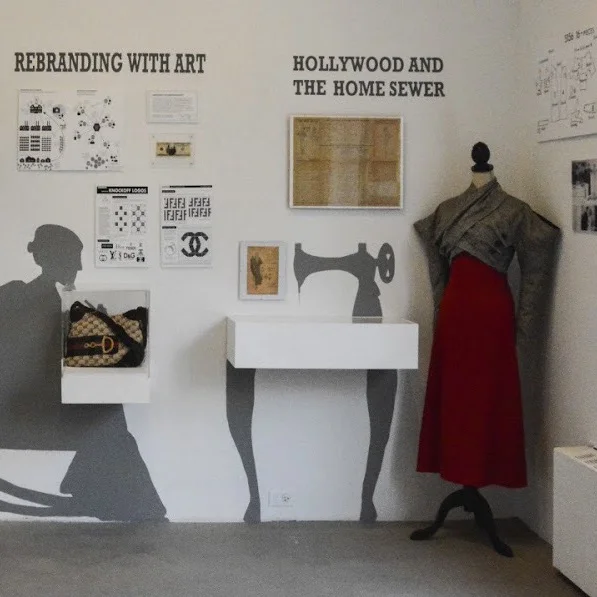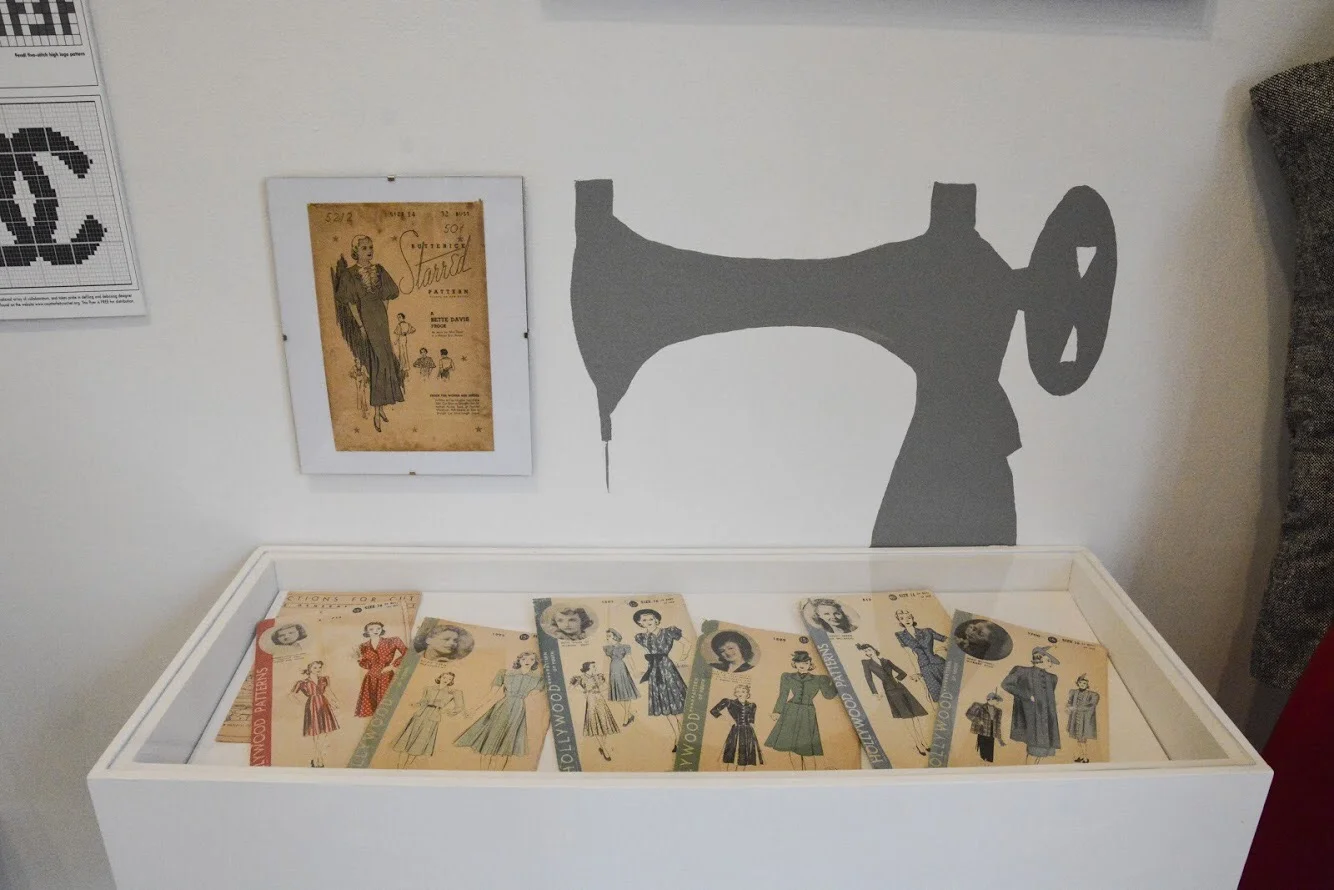Review: Gray Area: Authenticity, Value, and Subversion in Fashion
80WSE Gallery at New York University, New York, January 12 – February 2, 2019
Photo courtesy of NYU Costume Studies
“Another day, another influencer launching a line full of knock offs,” reads a recent Instagram post by fashion’s ever-popular watchdogs, Diet Prada. As the lines between inspiration, theft, and borrowing grow increasingly blurred, it is more vital than ever to consider how fashion has navigated the icy waters of defining “real” versus “fake,” the ways in which the industry encourages and promotes desirability, and moreover, how the system may evolve in the future. Each of these concepts was directly explored in Gray Area: Authenticity, Value, and Subversion, a recent exhibition at the 80WSE Gallery at New York University. The brainchild of current graduate students of the NYU Steinhardt Costume Studies program, the exhibition used technology, counterfeits, and even a pair of socks from Diet Prada themselves to illustrate how many of the conversations we have within the field of fashion studies are not cut and dried, not black and white, but rather an intricately layered and varied dialogue—indeed a gray area.
Eight vignettes lined the gallery walls, each one a careful assortment of objects addressing a different topic selected by one of the exhibition’s many co-curators. The almost claustrophobic space of 80WSE Gallery was filled to its brim, but not with the glitzy showmanship that often accompanies fashion exhibitions today. Rather, each of the show’s sections took a very fashion studies-centric approach to its topic—presented simply, with no frills, just a simple hand-painted silhouette to contextualize and bring collective cohesion to the various themes explored.
“As the lines between inspiration, theft, and borrowing grow increasingly blurred, it is more vital than ever to consider how fashion has navigated the icy waters of defining “real” versus “fake.” ”
The exhibition’s opening vignette, “The It Bag,” explored how modern technology is being utilized to counteract the trillion dollar counterfeit trade. Entrupy Inc., a company founded in 2012, that bills itself as “the world’s only on demand luxury authentication solution,” [1] was featured heavily in this first vignette. A looping video illustrated how Entrupy’s authentication device can be attached to a common iPhone, and how the accompanying software could use the phone’s camera and the device’s magnifying lens to provide almost instant authentication of handbags by fifteen of the world’s top luxury brands. The counterfeit trade, long associated with child labor, the drug trade, and even terrorism funding, has grown increasingly more advanced in its ability to create products that could fool even the most astute fashion professionals. Entrupy’s new technology allows for extremely detailed inspection of leather grain, printing technologies, hardware, and embossing to ensure that the bags are authentic.
To accompany Entrupy’s video, curator Carole Schinck also included two examples of Yves Saint Laurent’s iconic Monogram Collège handbag. Though the bags were not labeled, it was clear that one was a counterfeit, while the other was an authentic item. In the moment, the gallery visitor became the authenticator, trying to decipher from sight alone which was the “real” bag and which was the “fake.” It was striking to see the lengths to which counterfeiters go in order to dupe consumers. More importantly, it was arresting to realize that, oftentimes, consumers willingly purchase these fakes, even at a high cost, in order to participate in a broken system.
Photo courtesy of NYU Costume Studies
Curated by Marisa Lujan, a section titled “What’s in a Name” explored the way heritage brands have navigated the rocky terrain of both authenticity and innate value. Using legendary American hat brand Stetson as its case study, this section offered a harrowing glimpse into how some of fashion’s oldest and most respected brands have had to evolve in order to find contemporary relevance. Though Stetson manufactured the first cowboy hat in 1865, the brand has been forced to modify both the materials it uses and its target audience in order to remain relevant 150 years later. With two Boss of the Plains hats on display, one from the 1920s and the other from 2018, it is immediately clear that the brand has had to make production changes over time while maintaining a high quality product.
What Lujan’s curation perhaps best touches upon is how closely brand identity is associated with a name. Historically, as more manufacturers produced similar styles, the name “Stetson” was often applied to cowboy hats as a style rather than the name of its manufacturer. And in 2019, with the brand offering a full range of hat styles in addition to its classic cowboy hats, the name is recognized as the ultimate American heritage hat brand still affords it the association of quality, of innovation, and of tradition.
Curator Brian Centrone further complicated the definition of the word “authenticity” in his contribution to the exhibition: a delightful vignette named “Hollywood and the Home Sewer.” Rooted firmly in the traditions of the past, this part of the exhibition explored the now nearly forgotten art of home sewing and the long history of home sewing patterns. As Centrone explained, in the wake of the Great Depression, Americans turned to Hollywood for their fashion fix, often fashioning themselves after the screen sirens who proliferated in both film and television. Capitalizing on this, Butterick, a manufacturer of sewing patterns, began to produce dress patterns officially licensed by Hollywood studios, allowing the everyday consumer to don the same costumes as their favorite on-screen sirens. Sold at a premium cost, Butterick’s Starred Patterns were sold for just one year. However, their competitor, Hollywood Pattern Company, established a similar business model of producing unlicensed patterns of Hollywood-inspired costumes, which would enjoy a 17-year run.
“Today, the long respected tenants of authenticity, value, and subversion in fashion have all blended together to create a hybridized space. ”
What Centrone hoped to question in his display — a collection of Hollywood Pattern Company patterns as well as a fully realized frock ensemble based on one of Butterick’s patterns — was the changing definition of authenticity explored throughout the 1930s and 1940s when Hollywood was the definitive voice of fashion. Consumers had the option to pay a premium to create exact replicas of their favorite screen costumes, or pay less to create simplified versions “inspired by” the originals. Regardless, the success of their final product depended entirely on their own ability as a home sewer and access to the appropriate materials.
The section of the exhibition titled “Off the Brandwagon,” curated by Aanchal Bakshi, highlighted a case study by designer Ari Saal Forman and his ongoing exploration of value. Designed in 2006, Forman’s Menthol 10 was an impressive project that combined the insignia and designs of both Nike and the cigarette manufacturer Newport Tobacco Company to create a pair of sneakers. The resulting product seemingly advertised both of these hotly contested brands, along with a shoebox that resembled a cigarette pack. A tag printed on the inside of the shoes reads, “this sneaker is dedicated to the two brands who have taken the most and given the least. Thanks for the motivation…now it’s OUR turn!!!” Sneakerheads were quick to buy the Nike knockoffs, and Forman was served with cease-and-desist letters from both Nike and Newport. Today, Forman’s Menthol 10s can cost up to $10,000 on the resale market.
Menthol 10s Sneakers and Box, Ari Saal Forman, 2006. Courtesy of Private Collection. Photographed by Aanchal Bakshi for NYU Costume Studies, 2018. Image © Aanchal Bakshi.
Not only a commentary on the brand authenticity associated with fashion products, what Bakshi really got right was questioning the role of value within the fashion system itself. These sneakers almost immediately made a space for themselves in the vibrant world of sneaker culture, and it’s not just their rarity that makes them valuable, but also the complex story attached to them. Forman’s battles with some of the most powerful brands in the world combined with the attention paid to the finest details in the shoes themselves added to the allure of the product.
Today, the long respected tenants of authenticity, value, and subversion in fashion have all blended together to create a hybridized space. And designers are willingly entering that space, that gray area, to force consumers to question how they interact with fashion, materiality, and the system thereof. Design label Vetements, for example, famously co-opted the logos of Juicy Couture, DHL, and Champion, among other brands, in its Spring 2017 collection. It seems that, now more than ever, designers need to be in on the joke in order to participate in the conversation – and it highlights more than ever why fashion studies is not only relevant, but essential, to better understanding contemporary culture. Gray Area was a fashion studies dream, exploring complicated subjects and succeeding in a way that was refreshing, well considered, and intelligent.
Notes
[1] Entrupy. “Entrupy – Technology Driven Authentication Solution for Luxury Handbags.” Accessed March 31, 2019. https://www.entrupy.com/.





